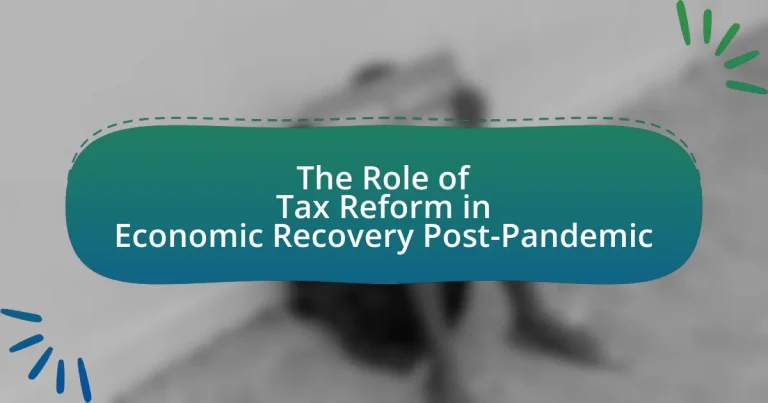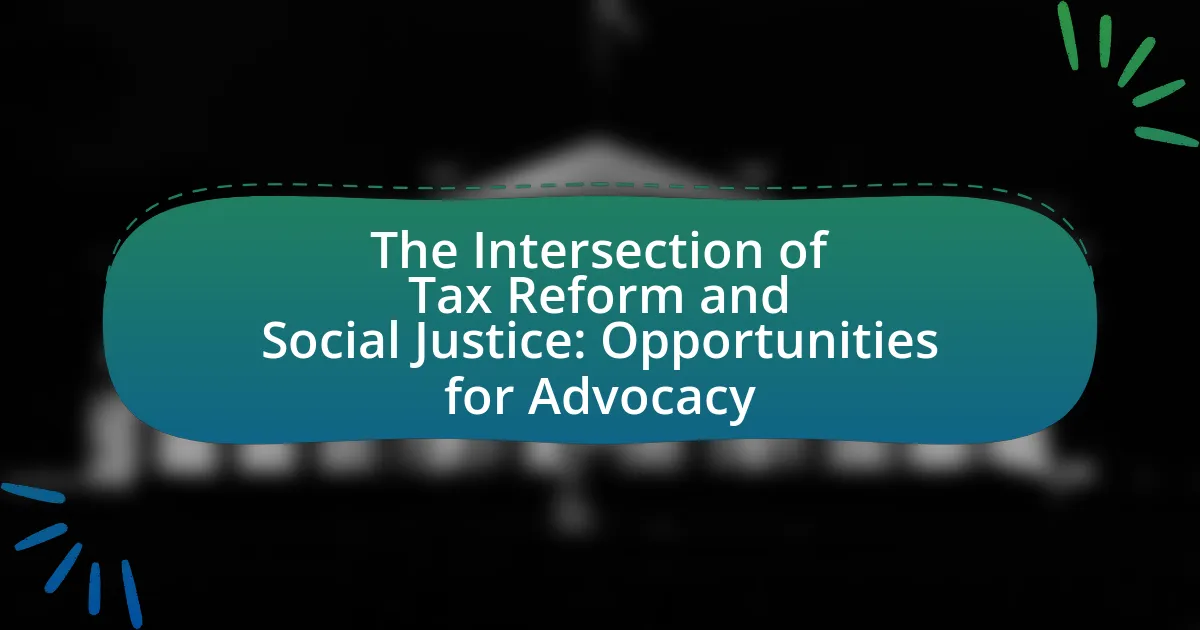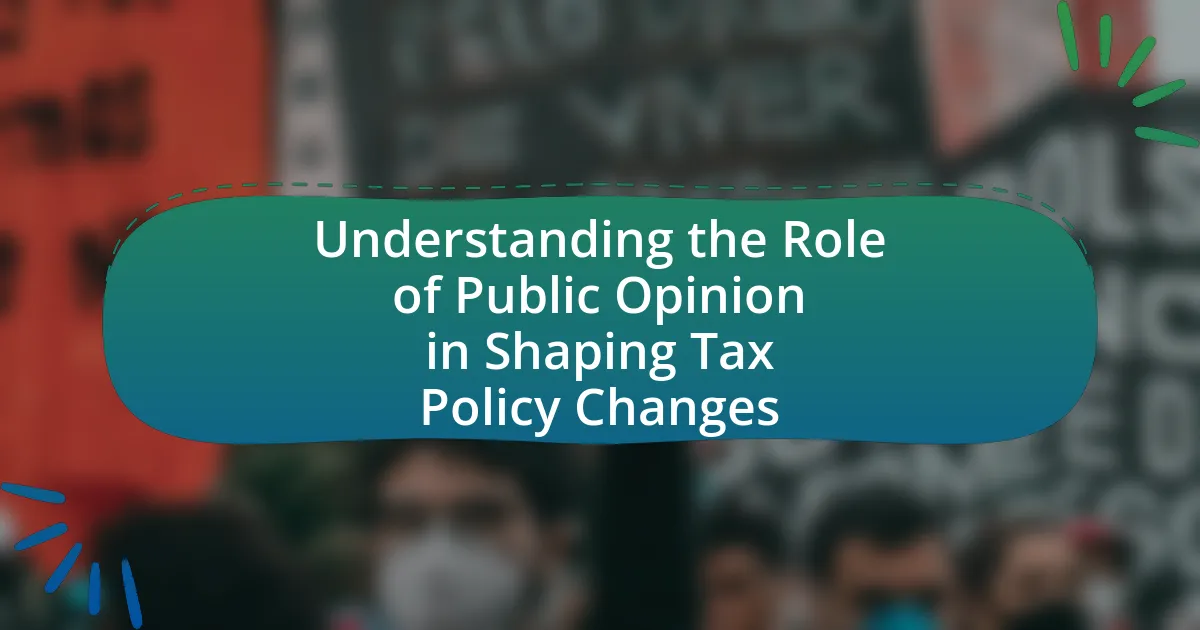Tax reform is a critical component of economic recovery in the aftermath of the pandemic, as it can stimulate growth and enhance government revenue. The article examines how adjustments in tax rates, credits, and deductions can influence disposable income, consumer spending, and business investment, ultimately driving economic revitalization. Key components of tax reform, such as targeted relief measures and incentives for specific sectors, are discussed, highlighting their role in addressing economic challenges and promoting job creation. Additionally, the article explores the implications of tax reform on low-income households and small businesses, emphasizing the importance of equitable and transparent policies for effective recovery.

What is the Role of Tax Reform in Economic Recovery Post-Pandemic?
Tax reform plays a crucial role in economic recovery post-pandemic by stimulating growth and increasing government revenue. By adjusting tax rates and structures, governments can incentivize investment, encourage consumer spending, and support businesses, which are essential for revitalizing economies affected by the pandemic. For instance, the Tax Cuts and Jobs Act of 2017 in the United States led to increased capital investment and job creation, demonstrating how tax reforms can positively impact economic recovery. Additionally, targeted tax relief measures during the pandemic, such as the Employee Retention Credit, helped preserve jobs and stabilize businesses, further underscoring the effectiveness of tax reform in fostering economic resilience.
How does tax reform influence economic recovery?
Tax reform influences economic recovery by altering disposable income levels and investment incentives. When tax rates are reduced, individuals and businesses typically have more disposable income, which can lead to increased consumer spending and business investment. For instance, the Tax Cuts and Jobs Act of 2017 in the United States resulted in a significant reduction in corporate tax rates, which incentivized companies to invest in expansion and hiring, contributing to economic growth. Additionally, targeted tax credits and deductions can stimulate specific sectors, such as renewable energy or small businesses, further enhancing recovery efforts. Historical data shows that effective tax reforms can lead to higher GDP growth rates, as seen in various post-recession recoveries.
What are the key components of tax reform that impact recovery?
The key components of tax reform that impact recovery include changes in tax rates, adjustments to tax credits and deductions, and the introduction of new tax incentives. Lowering tax rates can increase disposable income for individuals and businesses, stimulating consumer spending and investment. Adjustments to tax credits and deductions, such as expanding the Earned Income Tax Credit, can provide additional financial support to low- and middle-income families, enhancing their purchasing power. New tax incentives, like those aimed at encouraging business investment in underserved areas, can drive economic growth and job creation. These components collectively aim to boost economic activity and facilitate a faster recovery from the economic downturn caused by the pandemic.
How do tax incentives stimulate economic growth?
Tax incentives stimulate economic growth by encouraging investment and consumption. When governments reduce taxes on businesses and individuals, it increases disposable income and capital for reinvestment. For instance, a study by the National Bureau of Economic Research found that tax cuts can lead to a significant increase in business investment, which in turn drives job creation and economic expansion. Additionally, lower tax rates can attract foreign direct investment, further enhancing economic activity.
Why is tax reform essential for post-pandemic recovery?
Tax reform is essential for post-pandemic recovery because it can stimulate economic growth and enhance fiscal stability. By adjusting tax policies, governments can increase disposable income for individuals and businesses, leading to higher consumer spending and investment. For instance, the Tax Cuts and Jobs Act of 2017 in the United States resulted in a significant increase in GDP growth, demonstrating how tax reform can drive economic activity. Additionally, targeted tax incentives can support struggling sectors, such as small businesses and the hospitality industry, which were disproportionately affected by the pandemic. This strategic approach not only aids in immediate recovery but also lays the groundwork for long-term economic resilience.
What economic challenges does tax reform address?
Tax reform addresses several economic challenges, including income inequality, revenue generation, and economic growth stimulation. By adjusting tax rates and structures, tax reform aims to create a more equitable distribution of wealth, which can reduce disparities in income. For instance, progressive tax systems can alleviate the burden on lower-income households while increasing contributions from higher earners. Additionally, tax reform can enhance government revenue, enabling funding for essential services and infrastructure, which is crucial for economic recovery. Historical data shows that countries implementing tax reforms often experience increased investment and job creation, further driving economic growth.
How does tax reform affect consumer spending and investment?
Tax reform significantly influences consumer spending and investment by altering disposable income and business incentives. When tax rates are reduced, consumers typically have more disposable income, which can lead to increased spending on goods and services. For instance, the Tax Cuts and Jobs Act of 2017 in the United States resulted in a reduction of the corporate tax rate from 35% to 21%, encouraging businesses to invest more in expansion and hiring. This reform led to a reported increase in consumer confidence, as evidenced by a 4.5% rise in consumer spending in 2018, according to the Bureau of Economic Analysis. Additionally, tax incentives for capital investment can stimulate business expenditures, further driving economic growth. Thus, tax reform can create a positive feedback loop where increased consumer spending and business investment contribute to overall economic recovery.
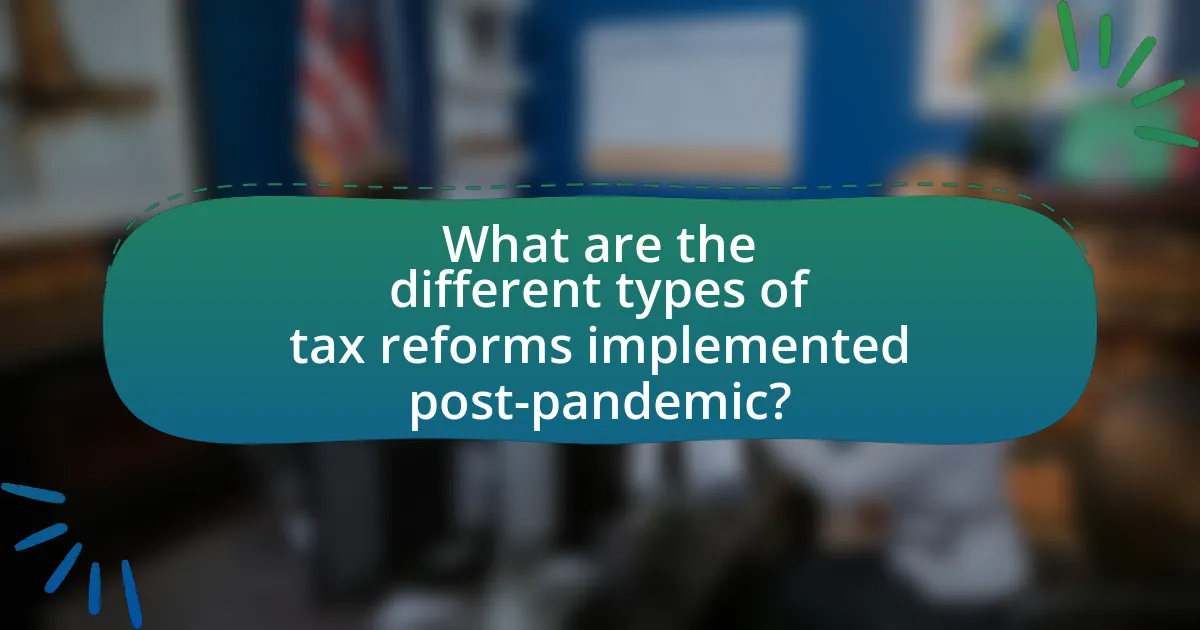
What are the different types of tax reforms implemented post-pandemic?
Post-pandemic, various types of tax reforms have been implemented, including tax relief measures, changes in tax rates, and adjustments to tax compliance requirements. Tax relief measures, such as temporary tax credits and deferrals, were introduced to support individuals and businesses affected by the economic downturn. Additionally, some governments adjusted tax rates, either increasing them for higher-income earners to fund recovery efforts or reducing them to stimulate spending. Changes in tax compliance requirements aimed to simplify processes and reduce the burden on taxpayers, facilitating easier access to benefits and incentives. These reforms were designed to promote economic recovery and address the financial challenges posed by the pandemic.
How do income tax reforms contribute to economic recovery?
Income tax reforms contribute to economic recovery by increasing disposable income for individuals and businesses, which stimulates consumer spending and investment. When tax rates are lowered or deductions are increased, households have more money to spend on goods and services, driving demand in the economy. For instance, the Tax Cuts and Jobs Act of 2017 in the United States resulted in a significant increase in after-tax income for many families, which contributed to a rise in consumer spending and economic growth. Additionally, tax reforms can incentivize businesses to invest in expansion and hiring, further boosting economic activity. Historical data shows that tax cuts can lead to higher GDP growth rates, as seen in various post-recession recoveries.
What changes were made to personal income tax rates?
Recent changes to personal income tax rates include a reduction in the top marginal tax rate from 37% to 35% for individuals earning above a specified threshold. Additionally, the standard deduction was increased, allowing taxpayers to reduce their taxable income more significantly. These adjustments aim to stimulate economic recovery by increasing disposable income for individuals, thereby encouraging consumer spending. The changes were enacted as part of broader tax reform legislation aimed at revitalizing the economy in the aftermath of the pandemic.
How do corporate tax reforms impact business investment?
Corporate tax reforms significantly influence business investment by altering the after-tax return on investment. When tax rates are reduced or incentives are introduced, businesses often experience increased cash flow, which can lead to higher levels of capital investment. For instance, the Tax Cuts and Jobs Act of 2017 in the United States lowered the corporate tax rate from 35% to 21%, resulting in a reported increase in business investment by approximately 6% in the following years, according to the Congressional Budget Office. This demonstrates that favorable tax reforms can stimulate economic activity by encouraging companies to invest in expansion, technology, and workforce development.
What role do tax credits and deductions play in recovery?
Tax credits and deductions significantly enhance economic recovery by increasing disposable income for individuals and businesses. These financial incentives lower tax liabilities, allowing taxpayers to retain more of their earnings, which can stimulate consumer spending and investment. For instance, the Economic Impact Payments and expanded Child Tax Credit during the COVID-19 pandemic provided direct financial support, leading to increased household spending and contributing to economic growth. According to the U.S. Treasury, these measures helped lift millions out of poverty and supported the recovery of various sectors, demonstrating the effectiveness of tax credits and deductions in fostering economic resilience.
Which tax credits were introduced to support businesses?
The tax credits introduced to support businesses include the Employee Retention Credit (ERC) and the Paycheck Protection Program (PPP) loan forgiveness. The ERC incentivizes employers to retain employees during economic downturns by providing a refundable tax credit for wages paid to eligible employees. The PPP, while primarily a loan program, offers forgiveness for amounts spent on payroll and certain other expenses, effectively acting as a tax credit for businesses that maintain their workforce. These measures were part of the Coronavirus Aid, Relief, and Economic Security (CARES) Act, enacted in March 2020, aimed at mitigating the economic impact of the COVID-19 pandemic on businesses.
How do deductions for individuals affect disposable income?
Deductions for individuals reduce taxable income, thereby increasing disposable income. When individuals claim deductions, such as for mortgage interest or charitable contributions, their overall tax liability decreases, allowing them to retain more of their earnings. For example, the Tax Cuts and Jobs Act of 2017 increased the standard deduction, which resulted in approximately 90% of taxpayers opting for it, leading to a significant rise in disposable income for many households. This increase in disposable income can stimulate consumer spending, which is crucial for economic recovery, particularly in the post-pandemic context.
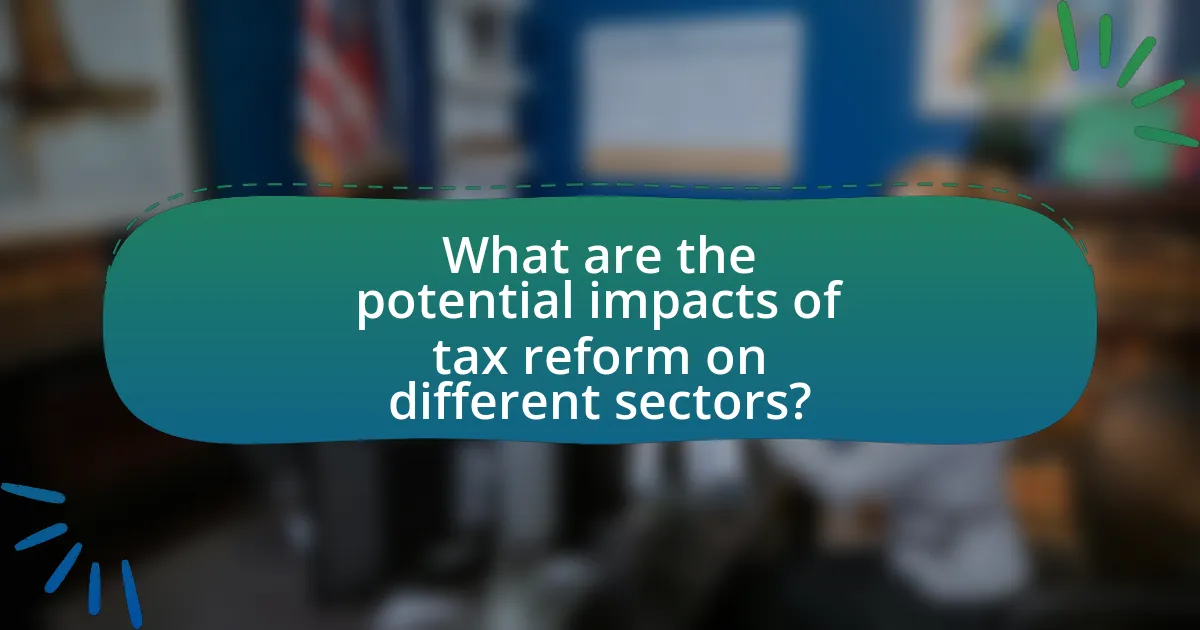
What are the potential impacts of tax reform on different sectors?
Tax reform can significantly impact various sectors by altering tax rates, incentives, and compliance requirements. For instance, the corporate sector may experience increased investment due to lower tax rates, as evidenced by the Tax Cuts and Jobs Act of 2017, which led to a 6.3% increase in business investment in the following year. Conversely, the healthcare sector might face challenges if reforms reduce funding for public health programs, potentially leading to decreased access to services. The real estate sector could benefit from tax incentives for homebuyers, stimulating demand and driving up property values. Additionally, small businesses may gain from simplified tax codes, allowing for easier compliance and potentially higher profits. Each sector’s response to tax reform is influenced by its specific economic conditions and regulatory environment.
How does tax reform affect small businesses specifically?
Tax reform affects small businesses by altering their tax liabilities, which can influence their cash flow and investment decisions. For instance, reductions in corporate tax rates can increase after-tax profits, allowing small businesses to reinvest in growth or hire additional employees. According to the Tax Cuts and Jobs Act of 2017, the corporate tax rate was lowered from 35% to 21%, which has been shown to benefit small businesses by providing them with more capital for expansion. Additionally, changes in deductions and credits can further enhance the financial position of small businesses, enabling them to navigate economic challenges more effectively.
What benefits do small businesses gain from tax reforms?
Small businesses gain several benefits from tax reforms, including reduced tax rates, simplified tax compliance, and increased access to capital. Reduced tax rates lower the overall tax burden, allowing small businesses to retain more earnings for reinvestment and growth. Simplified tax compliance reduces administrative costs and time spent on tax preparation, enabling small businesses to focus on operations and expansion. Additionally, tax reforms often include incentives such as credits or deductions that can enhance cash flow, making it easier for small businesses to secure financing and invest in their operations. For instance, the Tax Cuts and Jobs Act of 2017 lowered the corporate tax rate from 35% to 21%, significantly benefiting small businesses structured as corporations.
How do tax reforms help in job creation within small businesses?
Tax reforms help in job creation within small businesses by reducing the tax burden, which allows these businesses to reinvest savings into growth and hiring. For instance, the Tax Cuts and Jobs Act of 2017 lowered the corporate tax rate from 35% to 21%, enabling small businesses to allocate more resources toward expanding their workforce. According to the National Federation of Independent Business, 60% of small business owners reported that tax cuts would lead them to hire more employees. This reinvestment not only stimulates job creation but also enhances overall economic recovery, particularly in the post-pandemic landscape.
What are the implications of tax reform on low-income households?
Tax reform can significantly impact low-income households by altering their tax liabilities and access to benefits. For instance, changes in tax credits, such as the Earned Income Tax Credit (EITC) and Child Tax Credit (CTC), can either increase disposable income or reduce financial strain. According to the Center on Budget and Policy Priorities, enhancements to these credits during tax reform can lift millions of families out of poverty, thereby improving their economic stability. Conversely, tax increases or the elimination of deductions can exacerbate financial challenges for low-income households, leading to reduced spending power and increased reliance on social services.
How do tax reforms aim to reduce income inequality?
Tax reforms aim to reduce income inequality by adjusting tax rates and structures to favor lower and middle-income earners. These reforms often include progressive taxation, where higher income brackets are taxed at higher rates, thereby redistributing wealth. For example, the Tax Cuts and Jobs Act of 2017 in the United States included provisions that aimed to lower taxes for lower-income households while increasing the tax burden on higher earners through the elimination of certain deductions. Additionally, tax reforms may enhance social safety nets and public services funded by tax revenues, which disproportionately benefit lower-income individuals. Studies have shown that countries with more progressive tax systems tend to have lower levels of income inequality, as evidenced by data from the OECD, which indicates that progressive taxation can significantly reduce the Gini coefficient, a measure of income inequality.
What support measures are included for low-income families?
Support measures for low-income families include direct financial assistance, tax credits, and access to essential services. For instance, the Earned Income Tax Credit (EITC) provides significant tax relief to low-income working families, effectively increasing their disposable income. Additionally, programs such as Supplemental Nutrition Assistance Program (SNAP) offer food assistance, while housing vouchers help families afford stable housing. According to the U.S. Department of Agriculture, SNAP lifted approximately 3.1 million people out of poverty in 2020, demonstrating the impact of these support measures on economic stability for low-income families.
What best practices should policymakers consider for effective tax reform?
Policymakers should prioritize simplicity, equity, and transparency in tax reform to ensure effectiveness. Simplifying the tax code reduces compliance costs and enhances understanding among taxpayers, which can lead to higher compliance rates. Equity ensures that the tax burden is distributed fairly, promoting social justice and public support for the tax system. Transparency in tax policies fosters trust and accountability, encouraging taxpayer engagement and compliance. Historical evidence from the 2017 Tax Cuts and Jobs Act in the United States shows that simplifying tax brackets and reducing rates can stimulate economic activity, demonstrating the importance of these best practices in achieving successful tax reform.
How can transparency in tax reform enhance public trust?
Transparency in tax reform can enhance public trust by ensuring that citizens understand how tax policies are developed and implemented. When tax reforms are communicated clearly, detailing their objectives and expected outcomes, individuals are more likely to perceive the process as fair and accountable. For instance, a study by the International Monetary Fund in 2021 found that transparent tax systems lead to higher compliance rates and greater public satisfaction, as citizens feel their contributions are being used effectively. This understanding fosters a sense of ownership and engagement among the public, ultimately strengthening trust in governmental institutions.
What lessons can be learned from previous tax reforms during economic crises?
Previous tax reforms during economic crises demonstrate that targeted tax relief can stimulate economic recovery. For instance, the Tax Cuts and Jobs Act of 2017 in the United States aimed to boost investment and consumer spending through reduced corporate and individual tax rates, resulting in a temporary increase in GDP growth. Additionally, the implementation of temporary tax credits during the 2008 financial crisis, such as the Making Work Pay tax credit, provided immediate financial relief to households, which helped to stabilize consumer demand. These examples illustrate that timely and well-structured tax reforms can enhance economic resilience by promoting spending and investment during downturns.
